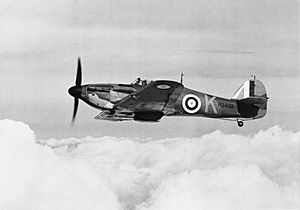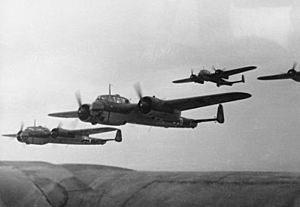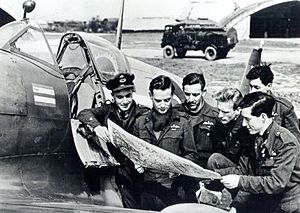Geoffrey Page facts for kids
Quick facts for kids
Geoffrey Page
|
|
|---|---|
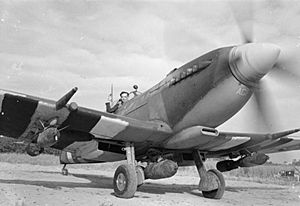
Page, in his Spitfire Mk. IX, about to take off on a sortie from Longues-sur-Mer, Normandy (1944)
|
|
| Born | 16 May 1920 Boxmoor, England |
| Died | 3 August 2000 (aged 80) Wokingham, Berkshire, England |
| Allegiance | United Kingdom |
| Service/ |
Royal Air Force |
| Years of service | 1939–1946 |
| Rank | Wing commander |
| Commands held | No. 125 Wing RAF No. 132 Squadron RAF |
| Battles/wars | Second World War
|
| Awards | Distinguished Service Order Officer of the Order of the British Empire Distinguished Flying Cross & Bar Officer of the Order of Orange Nassau (Netherlands) |
| Spouse(s) | Pauline Bruce (m. 1946–2000) |
| Relations | Sir Frederick Handley Page (uncle) |
| Other work | Salesman with the British Aircraft Corporation Founder of the Battle of Britain Trust |
Geoffrey Page (born May 16, 1920 – died August 3, 2000) was a brave pilot in the Royal Air Force during World War II. He fought in the famous Battle of Britain. During this battle, his plane was shot down, and he was badly burned.
Geoffrey was very lucky to survive. He had many surgeries to help him recover. He also became a founding member of the Guinea Pig Club, a special group for pilots who had been badly burned. Even after his injuries, he managed to return to flying. He became one of Britain's most successful fighter pilots.
Contents
Geoffrey's Early Life
Geoffrey Page was born in Boxmoor, England, on May 16, 1920. His parents separated when he was very young. From the age of five, Geoffrey loved airplanes and dreamed of flying.
He went to school at Dean Close School in Cheltenham. Geoffrey really wanted to join the RAF and become a pilot. However, his father wanted him to be an engineer instead. His uncle, Sir Frederick Handley Page, who built airplanes, also told him that engineers were more needed than pilots. Geoffrey later thought they might have worried about his safety, as their brother had been a fighter pilot in the Great War and died.
To please his father, Geoffrey went to London to study engineering. But he still found a way to fly! He joined the University Air Squadron. This group flew training planes from RAF Northolt. By his second year, Geoffrey was already a very good pilot.
World War II and Flying Adventures
Becoming a Fighter Pilot
Just two weeks after World War II began, Geoffrey joined the RAF. He trained at Cranwell and was an "exceptional" student. He always wanted to be a fighter pilot.
At first, he was told to be a flight instructor. But when Germany invaded other countries in May 1940, the RAF changed its mind. Geoffrey was sent to fly Spitfires with No. 66 Squadron RAF. He quickly learned how to fly these advanced fighter planes.
Soon after, there was a mix-up in orders. Geoffrey was supposed to be with 56 Squadron, flying Hurricanes. He moved to RAF North Weald to join them. This squadron had been fighting in France and had lost many planes. Geoffrey learned to fly the Hurricane and was ready for combat when his squadron returned. They helped protect ships during the Dunkirk evacuation.
Geoffrey was first disappointed to switch from Spitfires to Hurricanes. But he soon loved the Hurricane. He said it "rose gracefully and easily into the air." He found it easier to see out of and take off. The Hurricane was also tougher and could take more damage in a fight. He saw the Hurricane as a strong "bulldog" and the Spitfire as a fast "greyhound." He was happy to fly either one.
The Battle of Britain and Being Shot Down
In the late summer of 1940, Geoffrey's squadron was very busy in the Battle of Britain. They were constantly flying and fighting, which was exhausting. On July 13, Geoffrey shot down a German plane. On July 20, he helped shoot down a Junkers Ju 88 reconnaissance plane.
On July 25, his squadron helped British ships fighting German boats near Dover. German dive bombers, called Ju 87s, arrived with fighter planes. Geoffrey's squadron attacked them. He was credited with destroying a Ju 87.
On August 12, 1940, Geoffrey was flying his Hurricane, P2970. His squadron went to attack a large group of Dornier Do 17 bombers. As Geoffrey attacked, his plane was hit many times. The fuel tank broke, and high-octane fuel caught fire, spraying into his cockpit.
Geoffrey was badly burned on his hands and face as he tried to get out. He managed to parachute down into the English Channel. The smell of his burnt skin made him sick. He was picked up by a small merchant ship. This day marked the end of his first time flying in combat.
Recovery and the Guinea Pig Club
After being rescued, Geoffrey was taken to the burns unit at Queen Victoria Hospital in East Grinstead. His hands were burned to the bone, and his head was very swollen. He also had bullet wounds in both legs.
Scar tissue formed on his hands, making them hard to use. He was sent to a famous plastic surgeon, Archibald McIndoe. McIndoe was confident he could help, but it would take many surgeries and a lot of pain.
Geoffrey became friends with other burn patients, mostly young RAF pilots. They faced disfigurement and pain together. They formed a special club called the Guinea Pig Club. The name came from the experimental plastic surgery they were receiving. McIndoe was their president, and Geoffrey was the first chairman. The club helped them stay connected and support each other.
Because of his injuries, many thought Geoffrey could never fly a plane again. McIndoe even told him he had done enough. But Geoffrey was determined to return to flying. He had many operations to remove scar tissue and rebuild his face and eyelids. The pain was immense. He promised himself he would shoot down one enemy plane for each operation he endured.
In 1942, after 15 operations, Geoffrey was allowed to fly again, but only for limited flights. His first flight was terrifying; he feared being trapped in a burning plane again. But he pushed through his fear. Three months later, he was cleared for full combat flying.
Back in the Air
Geoffrey was assigned to No. 132 Squadron RAF. At first, they flew convoy patrols, which meant no air combat. He wanted to fight, so he volunteered to fly in North Africa. But the hot sun was bad for his skin grafts, so he returned to the UK after three months.
He then joined the Air Fighting Development Unit (AFDU). This unit compared different types of planes, both Allied and German. There, he met Squadron Leader James MacLachlan, another pilot who had overcome a severe injury (he lost an arm) to return to flying.
MacLachlan had an idea: fly low over occupied France in the early morning to surprise German planes. Geoffrey asked to try it too. They got a second plane, a Mustang, and on June 29, 1943, they flew south of Paris. In just ten minutes, they shot down six enemy planes! Geoffrey was awarded the Distinguished Flying Cross for this brave action.
On their next mission on July 18, MacLachlan's plane was hit, and he crashed, later dying from his injuries. Geoffrey returned to East Grinstead for more surgery on his hand.
In late 1943, Geoffrey joined No. 122 Squadron RAF. In January 1944, he took command of 132 Squadron. He trained his squadron in dive bombing, and they attacked German V-1 rocket sites. On April 29, Geoffrey led his flight over the Netherlands. They spotted a German Bf 110 night fighter.
Geoffrey's flight attacked. The German plane was flown by a skilled pilot, Major Hans-Joachim Jabs. Two Spitfires were hit by the Bf 110's powerful guns. Despite heavy anti-aircraft fire, Geoffrey managed to hit Jabs's plane as it made a hard landing.
In June 1944, the D-Day invasion began. Geoffrey and his squadron provided air cover over the beaches. He expected fierce air battles, but the German Luftwaffe was not there in force. After a week, his squadron moved to a new airfield in Normandy. Their job was to support ground troops. Geoffrey often took his plane out for "gun checks," which usually meant attacking German vehicles and sometimes fighting enemy planes.
In September 1944, Geoffrey's squadron supported the 1st Airborne Division at the Battle of Arnhem. During a mission, his plane was hit by ground fire, damaging its wings. He tried to land, but couldn't control his speed. The plane crashed hard, breaking apart. Geoffrey hit the gun-sight, breaking it, and fractured a bone in his back. He was pulled from the wreck unconscious.
Geoffrey was sent back to McIndoe for another operation. By this time, he had achieved 15 "kills" (enemy planes shot down). He had also received the Distinguished Service Order and two Distinguished Flying Crosses. Later, he was given the Officer of the Order of Orange Nassau by the Queen of The Netherlands for his role in the Battle of Arnhem. His DSO award said he had filled his entire wing with his fighting spirit.
After leaving the hospital in early 1945, Geoffrey went on a tour of the United States to improve relations between Britain and America. He met many famous people in Hollywood, including actress Joan Fontaine. He stayed with actor Nigel Bruce and became friends with C. Aubrey Smith.
In spring 1945, Geoffrey had more surgery. He then became a test pilot for Vickers-Armstrongs. He returned to England just as Germany surrendered. He left the RAF in 1946 as a wing commander. Later that year, he rejoined the RAF as a regular officer.
Life After the War
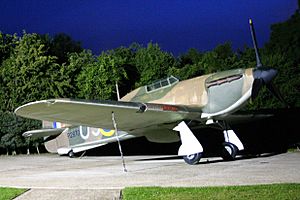
In 1946, Geoffrey married Pauline Bruce, the daughter of actor Nigel Bruce. Their wedding was in California.
Geoffrey became the commanding officer of No. 64 Squadron RAF, flying the de Havilland Hornet fighter. In 1947, he became a personal assistant to a senior RAF officer at the United Nations in New York. In 1948, he left the RAF and worked as a sales executive for Vickers-Armstrongs. Later, he became an aviation consultant, working internationally from Switzerland.
In his retirement, Geoffrey continued to lead the Guinea Pig Club. He also founded the Battle of Britain Trust. This charity raised over £1 million to build the Battle of Britain memorial overlooking the Straits of Dover. This memorial honors the pilots who defended Britain from Nazi Germany. For his efforts, he was made an Officer of the Order of the British Empire in 1995.
In 1981, Geoffrey Page wrote his autobiography, called Tale of a Guinea Pig. He dedicated the book to Archibald McIndoe, who "gave me back my pilot's hands." A new version was released in 1999, titled Shot Down in Flames.
Geoffrey Page passed away on August 3, 2000. He was survived by his wife, Pauline, and his three children, Shelley, Nigel, and Jamie.
Awards
 United Kingdom: Distinguished Flying Cross (July 30, 1943)
United Kingdom: Distinguished Flying Cross (July 30, 1943) United Kingdom: Distinguished Flying Cross (August 22, 1944)
United Kingdom: Distinguished Flying Cross (August 22, 1944) United Kingdom: Distinguished Service Order (December 29, 1944)
United Kingdom: Distinguished Service Order (December 29, 1944) Netherlands: Officer of the Order of Orange Nassau (January 23, 1948)
Netherlands: Officer of the Order of Orange Nassau (January 23, 1948) United Kingdom: Officer of the Order of the British Empire (June 17, 1995)
United Kingdom: Officer of the Order of the British Empire (June 17, 1995)


